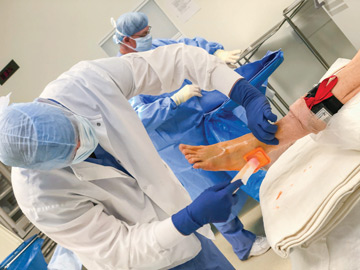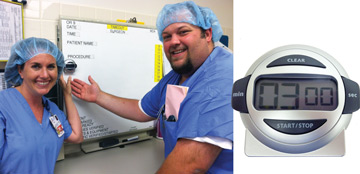Skin prepping is serious business at our facility. So serious, in fact, that the staff who prep patients before surgery wear different colored gowns than the rest of the OR team. The designated pink gowns — a visual signal to everyone in the OR that nurses and doctors in pink are performing a critical process and are not a member of the sterile field — are a part of our standardized skin prep protocol that we rolled out in 2017. Like all changes, it hasn't always been easy to convince staff the extra steps — not to mention attire — were necessary. But with patience and persistence, we've managed to ingrain these critical safety standards into the collective psyche of our staff. Here's how we made proper skin prep a top priority, and how you can do the same.
1. Preppers wear pink gowns. Like the bulk of our protocols, we started wearing designated prep gowns as a direct result of AORN's skin antisepsis guidelines, which require the person doing the prep to have her arms fully covered to contain shedded skin particles. Whenever AORN puts out or revises a practice standard, it's evidence-based, so our goal is to meet that guideline. Of course, these guidelines don't tell you every granular detail of what you need to do. It's up to you to figure out a way to make everything work in your specific setting. For us, that meant some trial and error. We knew we wanted to have the staff who did the actual prepping wear something that made them stand out from the rest of the team in the OR. After all, the Joint Commission requires you to have some way of signifying a critical process is taking place; a designated skin prep gown certainly checks that box. But it took a little while to settle on what we wanted them to wear.
Initially, we tried disposable scrub jackets, which we found were too baggy and loose for the prepping task. We ultimately settled on a level-3 gown, which was more convenient and appropriate for staff to wear. Plus, at $1 to $1.50 per gown, it was a cheaper option.
The vendor we went with is very committed to breast cancer awareness, so the gowns are pink — a color that really stands out from the rest of the blue scrubs in the OR. When a nurse dons a pink gown in our ORs, the surgical team knows she's there for one critical task: to prep the patient for surgery with a surgeon-approved skin prep antiseptic. Everyone knows that a critical process is underway and the person/persons in pink (most prepping is handled solely by our circulator, but some cases will require 2 staff members) aren't members of the sterile field. The gowns not only cut down on disruptions — everyone knows not to interrupt the person prepping the patient — but they also help us prevent infection, as the gown fully covers the nurses' arms so those squamous epithelial cells don't fall into the sterile field.
If you're thinking of going the designated gown route, be prepared: You're bound to at least get an influx of questions in the beginning. Why do we need an extra gown? What's wrong with the way we've always done things? As a facility leader, you'll need to be patient, persistent and, above all, informative about the "why" part of your processes.
.svg?sfvrsn=be606e78_3)


.svg?sfvrsn=56b2f850_5)